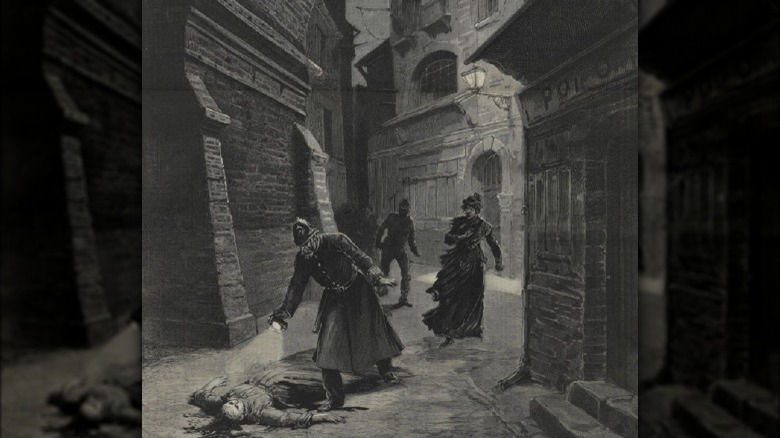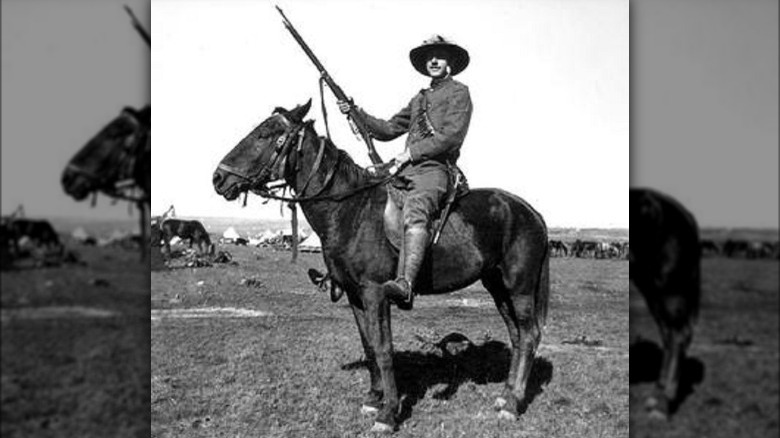The First Widespread Theory About Jack The Ripper's Identity Explained
There are a number of unsolved cases that have captured the interest of true crime enthusiasts for years. Some of them include the case of the Black Dahlia, the murder of JonBenet Ramsey, and the Villisca Axe murders, just to name a few. One of the oldest unsolved mysteries is the identity of Jack the Ripper, the serial killer who terrorized the streets of London in the late 1800s.
Jack the Ripper murdered women in the general area of Whitechapel, an impoverished area in London where many immigrants resided. The area was disease-ridden, crimes were rampant, and violence was an everyday occurrence. Those who lived in Whitechapel resided in cramped homes that had barely enough space for sleeping and cooking (via The Jack the Ripper Tour). It is believed that Jack the Ripper's first murder occurred on August 31, 1888. The victim was a 42-year-old woman found with her throat slashed and her abdominal area brutally injured. More women were killed in the following weeks, but since the identity of Jack the Ripper is unknown, there is no knowing how many people he truly murdered. Most historians agree that he was responsible for at least five of the reported murders, known as the "Canonical Five." They were Mary Ann Nichols, Annie Chapman, Elizabeth Stride, Catherine Eddowes, and Mary Jane Kelly.
Why wasn't he caught?
There are many who believe that Jack the Ripper would easily be caught if the murders occurred today. Back then, however, authorities came across so many challenges. Per London Walks, murder was not a common crime in Victorian London. In the metropolitan district, there were 58 murders reported from 1887 to 1889. It was so uncommon, in fact, that there were only 27 inspectors who dealt with major crimes in the entirety of Whitechapel, a district known for violent activities.
Another major factor was the lack of technology. There had no means to test for DNA, blood typing wasn't even used, and fingerprinting wasn't invented yet. For these reasons, inspectors typically relied on eyewitness accounts, which weren't — and still aren't — always reliable. Per Mr. Lupton History, inspectors received plenty of tips from the public, but many of them were false information that only muddled the investigation. This isn't to say that the inspectors didn't do everything they could have done to catch Jack the Ripper. Some even went as far as disguising themselves as women in hopes of catching the killer in the act. Despite the efforts, they weren't able to apprehend Jack the Ripper, as they were simply ill-equipped in solving murders at that time.
Leonard Matters' theory about Jack the Ripper
The identity of Jack the Ripper remained a mystery, and many people speculated about him. The earliest widespread theory about Jack the Ripper's identity came from Leonard Matters (pictured above), a journalist and amateur crime writer who released the book "The Mystery of Jack the Ripper" in 1929 (via The Jack the Ripper Tour). In it, Matters stated that Jack the Ripper was a man named Dr. Stanley. The doctor worked at a hospital in London but also had a private practice.
According to Matters, Dr. Stanley had a son named Herbert who fell in love with a sex worker named Mary Jane Kelly. Unbeknownst to Herbert, Kelly had syphilis and he contracted the infection, which killed him a couple of years later. Matters claimed that Dr. Stanley targeted sex workers as a form of revenge for his son's death until he finally killed Kelly. Matters' book was the first full-length publication about Jack the Ripper and inspired the movie "Jack the Ripper," which was released in 1959.
Leonard Matters' theory debunked
Leonard Matters' theory was fascinating, and he claimed that his source was a Spanish article that he read in an Argentinian publication. However, many researchers looked into his claims and found no evidence to back them up (per the University of New England). Furthermore, the documentation he provided as references for his book was never found. Still, his theory was interesting enough to turn into a movie.
There were also other facts that contradict Matters' claims, such as the profile of the victims. As his theory goes, Dr. Stanley targeted sex workers. However, the Canonical Five weren't all sex workers. According to Penguin, the five women were all found in reclining positions with no signs of struggle. This suggests that Jack the Ripper attacked them as they slept, and at least some of them were not sex workers but instead, just women who lived on the streets. Although Leonard Matters' book consisted of the first widespread theory about the identity of Jack the Ripper, it certainly wasn't conclusive.
Clues about Jack the Ripper's identity
Over the years, many attempts have been made to try and identify Jack the Ripper. In 2007, as Science noted, a man purchased a shawl that was reportedly found next to the body of Catherine Eddowes, one of the Canonical Five. The shawl was stained with semen and blood and upon testing, some experts claimed that it revealed the identity of the killer who was one of the earlier suspects, a man named Aaron Kosminski. Testing has also confirmed that Jack the Ripper had brown hair and brown eyes, which fit Kosminski's description.
Despite the outcome, however, Smithsonian Magazine reported that it can't conclusively say that Kosminski was Jack the Ripper. The authenticity of the shawl was brought into question, and historians claim that there is no evidence or documentation available that proves the shawl was collected from Eddowes' crime scene. Experts also said that only mitochondrial DNA was tested, which doesn't uniquely identify a suspect and can only exclude suspects from the list. Furthermore, there have also been suggestions that Jack the Ripper may have been a woman.
Jack the Ripper suspects
Apart from Leonard Matters, many people had their own theories about Jack the Ripper. Some believe he was a doctor, while others say he was a butcher. The suspects came from different walks of life, but there were some who were more suspicious than others. One of them was Aaron Kosminski, the man whose DNA was allegedly found on the shawl. Kosminski was in his early 20s and worked as a hairdresser during the Jack the Ripper murders, according to Whitechapel Jack. He was a Polish Jew who spent time in an asylum.
Another popular name connected to the Whitechapel murders was Walter Sickert, a painter who said he once lived in Jack the Ripper's former home. He also titled one of his works "Jack the Ripper's Bedroom." There's no concrete evidence confirming he was Jack the Ripper, and he wasn't in London when some of the murders occurred.
Many suspect that serial killer Dr. Thomas Cream was Jack the Ripper. The doctor murdered his victims using poison, which doesn't fit Jack the Ripper's profile, but before he was executed for his crimes in 1892, he reportedly said, "I am Jack ... " but was killed before finishing his sentence, per Mental Floss.





